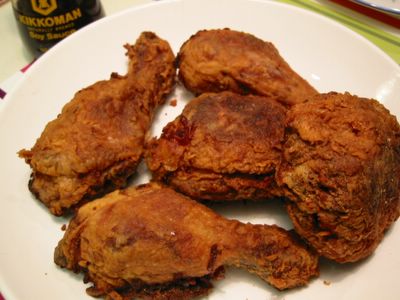
All descriptions I have heard or read about authentic Southern Fried Chicken were always in the superlatives. I emphasise 'authentic' there because we have these plethora of so called southern fried fast food pieces that they say do not bear much resemblance to the real thing. One of the list of my must do things in my foodie life is to have the real mccoy in the deep south of the US. I think Jmom can help me if ever I am there. ;) I gotta have a taste of the real thing and other southern specialties like grits, gumbo, corn fritters, etc. Meanwhile, I found a nifty recipe from Lesley Allin's Great American Food. She says that despite the variations to this dish, there a few rules that southern cooks adhere to. Among them is the use of a cast iron skillet and that the chicken is fried not deep fried. Curious to know that she also recommends using brown paper bags for draining to retain the crispiness instead of using paper towels. Now that I haven't tried before.
I followed her recipe and procedures (making some adjustments of course) for at least 3 times and I could say that it undeniably produced fried chicken with a very crispy outside but juicy inside. I also tried both lard and vegetable oils. Lard wins hands down in terms of taste. It was really yummy especially the gravy. But my golly, when I saw how it solidified in the pan after just a short time of cooling off I could almost feel my arteries constricting! Reluctantly, I have to let go of the lard to save my arteries from clogging. Maybe I'll have it like ... mmm ... once every year. ;)
Getting back to the crispiness, maybe it's to do with the buttermilk and the flour. There certainly wasn't any fancy ingredients in there. Maybe the cast iron skillet has something to do with it lending its even heating properties to the frying. The resulting fried chicken when eaten on its own is actually a bit bland because we only put 1 tsp salt for every cup of flour. However, when you have it with the gravy - pow wow brown cow! Super deeeelicious! Another peculiar thing I noticed here is the addition of the lemon juice in the gravy. I seriously thought it would ruin it or curdle it, but oh no it even brought out the creaminess of the gravy and gave a nice sour-salty taste. Yum! Oh drat, I drooled on my keyboard !! yaaah ...


Southern Fried Chicken
1 - 1.5 kg chicken - cut into serving pieces
250 - 500 ml (1-2 cups) buttermilk*
120 g (1 cup) plain flour
1 tsp fine salt
1/2 tsp freshly ground pepper
1/8 tsp cayenne pepper
Lard or vegetable oil for frying
4 smoked streaky bacon - chopped thinly
375 ml (1 1/2 cups) chicken stock
125 ml (1/2 cup) double cream (heavy cream)
1-2 Tbsp lemon juice
- Marinate the chicken pieces in the buttermilk for at least 2 hours or better if overnight. Let it come to room temperature before cooking.
- Mix flour, salt, pepper, and cayenne pepper in a plastic bag. Take the chicken, one at a time, from the buttermilk and put in the plastic bag with flour mixture. Twist the end of the bag to close and shake well to coat the chicken evenly. Repeat with all the chicken pieces. Set aside 2 Tbsp of the used seasoned flour.
- Heat 1/2-inch layer of lard or vegetable oil in a cast iron skillet/frying pan. Add in the bacon. Fry until crispy. Remove bacon and drain on paper towels; set aside.
- Add the flour-coated chicken in the hot fat putting the serving or presentation side down first. Do not crowd the chicken in the pan. Cover and cook in medium heat for 15 minutes.
- Remove cover and turn chicken with tongs. Do not use fork because it will pierce the meat and thereby lose its juiciness. Fry uncovered for a further 10-15 minutes. Take out the chicken from the pan and drain in a brown paper bag or on paper towels just make sure not to let them linger on the towels too long or it will go soggy.
- Drain all but 2 Tbsp of the oil from the frying pan leaving behind all the brown bits at the bottom. Add in the reserved 2 Tbsp seasoned flour. Cook until lightly browned. Add the stock, cream, and lemon juice and bring to boil while whisking constantly until sauce is smooth and thick. Taste and add more seasonings it necessary.
- You may add the crisp fried bacon to the gravy or sprinkle them over as a garnish if you wish. Serve with some mashed potatoes.
*Note: If you don't have any buttermilk, you can substitute with the following: for every cup of buttermilk, put in scant 1 cup of milk in a non-metal container then add 1 Tbsp vinegar or lemon juice to make 1 cup; do not stir, let stand and curdle for about 5-10 minutes.

I swear this looks orange-coloured in person. I made sure to add enough colouring to make it passable for this month's IMBB. The orange-reddish tint in the noodles is courtesy of the natural food colouring from the annato seed. Also called achiote or achuete, it is a native of South America and has been used for centuries as source of red colouring for food, cosmetics, and body paints. The PinoyCook has a some more info and pictures of this essential cooking ingredient.
Okay just to be sure here's another picture of the dish to highlight its orange hue. ;) Why do I sound so insecure?
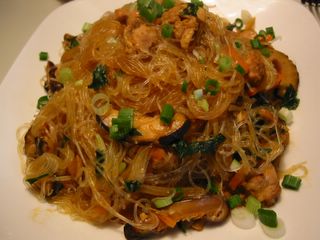
I've always enjoyed the monthly IMBB food blogging event. It always gets me on my toes and have me scouring the deep recesses of my brain (and my stomach) of what to cook up. Like this edition, which incidentally is currently hosted by Foodgoat, demands food of the orange hue. It got me thinking a whole host of food ranging from Ginisang Carrot to Ginisang Kalabasa (squash). Hehehe. Is that all I can think of - ginisa (sauteed)?? Seriously, I was planning on making orange-glazed sweet potato (kamote!) or pancit palabok. But decided on doing this since it's not often that my family have this for lunch.
Sotanghon is the Filipino name for glass noodle (also bean thread noodles). While 'gisado' mean sauteed. Some people call this dish just Sotanghon but then they also call another soupy dish with this type of noodles of the same name. So I decided to append the 'Gisado' to indicate that it's cooked similar to that popular Pancit Bihon Gisado. Of paramount importance here is the quality of your chicken stock because the noodles will absorb it all and will therefore reflect its quality. If you can't or don't have time to make your own stock, local supermarkets usually have fresh meat or vegetable stocks in the chilled shelves. Otherwise, I recommend the Kallo brand of stock cubes - they do both organic and non-organic varieties.
Sotanghon Gisado
500 g boneless chicken meat - sliced into 1/2-inch pieces
200 g sotanghon (beanthread or glass noodles)
2 Tbsp oil
1 Tbsp minced garlic
1 medium onion - sliced
1 Tbsp patis (fish sauce)
2 1/2 cups chicken stock + 1/4 cup extra
4 dried shiitake mushrooms (or woodears/black fungus)
1/2 cup julienned carrots
1/4 cup chopped Chinese parsley or kinchay (or flatleaf parsley)
1 Tbsp annatto seeds or 1/2 tsp annatto powder (also called achuete or achiote)
1/3 cup hot water
2 green onions - chopped
salt and pepper to taste
- Soak sotanghon in water until soft (about 20 minutes). Drain and cut into desired lengths.
- Mix annatto seeds with the 1/3 cup hot water. Let stand for about 20 minutes. Mix and mash with fingers to extract red dye from the annatto and mix in with the water. Strain and discard annatto seeds. (If using annatto powder, just mix it with the water.)
- Pour enough hot water on the dried shiitake mushrooms enough to cover it. Soak for 20 minutes or until soft. Drain and squeeze excess water from mushrooms. Cut off stems and discard. Slice mushrooms thinly.
- Heat oil in a wok. Saute garlic and onion.
- Add chicken meat and patis; saute for awhile.
- Add 1/4 cup chicken stock and simmer in medium heat until chicken is just cooked (about 10-15 minutes). Let it dry out a little.
- Add chicken stock and annatto water; bring to boil. Stir in carrots, mushrooms and parsley. Simmer for 3-4 minutes.
- Add in sotanghon noodles, mix well and cook for another 2-3 minutes or until noodles is soft and cooked through. Put in salt and pepper according to your taste. Garnish with chopped green onions. Dish up and serve. (There will be some sauce left at this end stage. Don't worry, it will all be absorbed by the noodles as it cools down.)
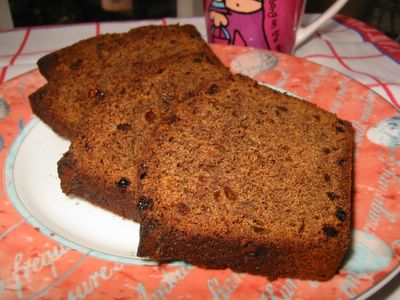
My 4-year-old daughter was jumping with joy when I told her I was making gingerbread. She thought people-shaped cookies would come out of the oven. I had to explain that it's gonna be as name implied - a bread. Good thing she 'helped' me in the baking nonetheless. First time for me to create this dark, smoky, rich bread. I actually was not very hopeful of a good outcome but other than the slightly burnt crust it was great. Admittedly the taste's not for everyone though my friends loved it. It's not very sweet and the tiny morsels of sultanas and ginger provides islands of pleasing jelly-like sugary nuggets. Brian Turner's Favourite British Recipes cookbook (where I adapted this recipe) suggested that it's very good served with vanilla ice cream or whipped cream and indeed it is!
Oh by the way, before I forget this is my entry to the Sugar High Friday #7 - the food blogging event currently hosted by Derrick of Obesssion with Food. Theme for this edition is molasses. Derrick said we could substitute treacle and thank god for that 'coz molasses is not very common in the supermarkets of this island. The ones I often come across is black treacle which I thought was just the British name for molasses. But I found out that technically there is a difference. See, molasses is created from the drainings of raw sugar during refining while treacle is obtained from syrup made from the sugar (whatever that means). A good website explaining this is in here.
Gingerbread
115 g unsalted butter - softened (scant 1/2 cup)
225 g plain flour (1 2/3 cup)
115 g golden caster sugar (1/2 cup)
2 eggs - beaten
225 g black treacle, lightly warmed (1/2 cup + 2 Tbsp)
55 g sultanas - finely chopped (1/3 cup)
85 g preserved ginger - finely chopped (1/3 cup)
2 tsp ground ginger
2 Tbsp double cream (heavy cream)
1/2 tsp bicarbonate of soda (baking soda)
- Butter and flour well a 2 lb (9 x 5-inch) loaf pan. Preheat oven to 160°C/fan 140°C/325°F/Gas Mark 3.
- Cream (beat) butter and sugar in a bowl.
- Mix in eggs, black treacle, sultanas, and preserved ginger.
- Stir in the flour and ground ginger.
- Warm the cream slightly then add in the bicarbonate of soda and mix into the flour mixture.
- Pour into the loaf pan and bake in the oven for 1 1/2 hours. Cover top with foil halfway through if it is browning too much.
- Remove from oven and leave to cool in the pan. Turn out into a serving plate. Serve slices with ice cream or whipped cream.

Here's a chicken chow mein with a twist. I find marinating the meat in satay sauce gives it a bit of a bite and a nice rich taste. I've been doing this for years but always forget to write down my adjustment to the recipe in the Australian Women's Weekly Chinese Cooking Class cookbook. Finally nailed it down this week when my kids requested some 'noodle thingie'. The originally recipe is too salty to our taste so I have to tone it down considerably plus we wanted more noodles than meat so that one was reduced as well. Easy to make and I'm sure would go down well with the family.
Chicken Satay Chow Mein
350 g boneless chicken meat - cut into about 3/4-inch pieces
2 Tbsp oil
*Marinade:
1 Tbsp soy sauce
1 tsp chilli sauce [optional]
1 Tbsp cooking wine
1 1/2 Tbsp bottled satay sauce
*Noodles:
250 g egg noodles
1 Tbsp oil [optional]
*Vegetables:
1 Tbsp oil
1 medium onion - sliced
1/2 Tbsp minced garlic
125 g small mushrooms - sliced
1/2 red bell pepper - sliced
125 g mangetout (sitcharo) - topped and tailed
125 g bean sprouts (togue)
*Sauce:
1 tsp sugar
2 tsp cornstarch
1/2 cup chicken stock
1 Tbsp cooking wine
1 1/2 Tbsp oyster sauce
1 Tbsp soy sauce
- Mix sliced chicken and all marinade ingredients in a container. Marinate in the fridge for at least 1 hour.
- Cook egg noodles in boiling water according to the package instructions. Stir fry noodles briefly in 1 Tbsp of oil and dish up in a serving plate OR just toss the noodles with 1 Tbsp oil and put in a serving plate.
- In another bowl combine all ingredients for the sauce. Set aside.
- Heat 2 Tbsp oil in a wok. Fry chicken with the marinade until thoroughly cooked (about 10 minutes). Push to one side of the wok.
- Saute garlic and onion in the wok until aromatic.
- Add in mushrooms, mangetout, and bell pepper. Stir fry for a few seconds.
- Mix in the chicken and stir fry for about 2-3 minutes.
- Add bean sprouts, stir fry for about 1 minute.
- Stir in the sauce and bring to boil until thick. Give it a stir for a few seconds. Dish up and pour on top of the cooked noodles.
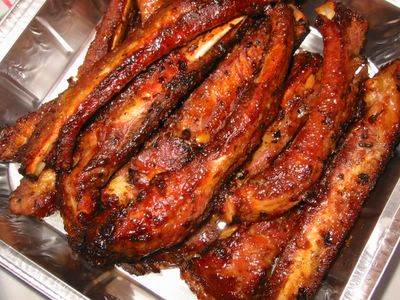
Until I can take a better picture of a better cut of ribs for this post, we'll have to bear the pathetic looking ribs above. Though mind you, it sold out very fast when I took it to a friend's party. The meat cut most suitable for this is meaty pork ribs preferably with the skin still on. The day I made this I was in a panic because I can't find the right cut so I had to make do with these spare ribs from the supermarket.
I love the tangy-sweetish taste the plum sauce imparts and the hint of spiciness from the chilli sauce. The recipe is good also for barbecues or oven grills. You just have to oven bake it first to tenderise and thoroughly cook the meat then brown it in the barbecue or grill. That's now my standard cooking method for ribs ever since I read it from an American cookbook. This one, however, is adapted from the Australian Women's Weekly's Chinese Cooking Class cookbook.
Pork Ribs with Chilli Plum Sauce
750 g meaty pork ribs
1 Tbsp oyster sauce
2 Tbsp cooking wine (dry sherry or rice wine)
1 Tbsp soy sauce
1 Tbsp fermented black beans
1 1/2 tsp five spice powder
1/4 tsp ground black pepper
1/4 tsp salt
*Chilli Plum Sauce:
3/4 cup bottled plum sauce
1/2 tsp chilli sauce
2 tsp oil
1 clove garlic - minced
1/2 tsp grated ginger
2 shallots (sibuyas tagalog) - chopped
1/3 cup stock
2 tsp soy sauce
2 tsp cornflour
*For the Chilli Plum Sauce:
- In a saucepan, heat oil and saute garlic, ginger, and shallots. Cook over gentle heat for 1 minute.
- Remove from heat. Add plum sauce and chilli sauce. Mix until combined.
- Add combined water, crumbled stock cube, soy sauce, and cornflour.
- Return saucepan to heat. Stir until sauce boils and thickens. Remove from heat and set aside.
*For the pork ribs:
- Preheat oven to 200°C/fan 180°C/400°F. Cover black beans with water and soak for 15 minutes. Drain, mash with fork.
- In a bowl combine oyster sauce, cooking wine, soy sauce, mashed black beans, five spice powder, salt and pepper.
- Coat (or dip) each rib with black bean mixture. Put in a large baking pan, cover tightly with foil and bake for 1 hour or until fork tender. Turn ribs halfway through the baking.
- Remove foil and brush ribs with plum sauce. Return to oven and bake for another 25-30 minutes; turning the ribs halfway through. Or instead of baking further, grill in a barbecue until golden brown. Serve with remaining sauce.
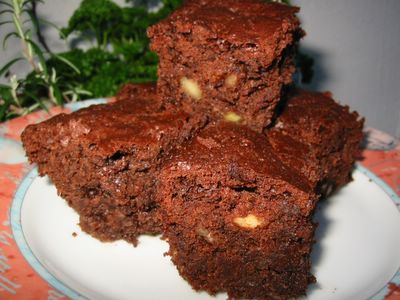
Another brownie recipe. Blame the bananas. My abhorrence to throwing away overripe bananas from our fruit basket has led me to look for alternative uses to it all the time. Any new recipes are welcome. If the family loves it, it will become a classic to come back to over and over again. Otherwise, it's been nice trying them. This one is something of a delightful surprise whose taste, texture, and smell I truly truly love. The banana gives a wonderful aroma blended with the characteristic wonderful whiff of the chocolate while the muscovado sugar lends a treacle-like flavour. My kids though, find the flavours a bit too strong. For their benefit (maybe just maybe), next time I bake this I have to reduce the chocs and probably the sugar. But if you like your brownies very chocolatey, a little fudgy, crumbly, and quite moist then this is for you.
Adapted from BBC GoodFood Magazine's 101 Cakes & Bakes.
Banana Nut Brownies
175 g butter - cut into pieces
300 g [1 2/3 cups firmly packed] light muscovado sugar
150 g dark chocolate - broken into pieces
100 g [3/4 cup] nuts - chopped
3 eggs - beaten
1 cup mashed bananas (about 2-3 bananas)
100 g [3/4 cup] self-raising flour
1 Tbsp cocoa powder [optional]
1/2 tsp baking powder
- Preheat the oven to 180C/fan 160C/350F/gas mark 4. Butter and line a 7 x 11-inch baking pan with greaseproof paper.
- Melt butter, chocolate, and sugar in a heatproof bowl over a saucepan of simmering water. Remove from heat.
- Sift flour, cocoa [optional], and baking powder in a separate bowl. Mix well.
- Add in nuts, mashed banana, and eggs to the chocolate mixture.
- Fold in the flour mixture to the chocolate-banana mixture.
- Pour batter into the lined baking pan and bake for 40 minutes or until firm in the centre.
- Cool in the pan; turn out and cut into squares.
*Update 26/05/07: Reduced chocolate from 175 gm to 150 gm. Reduced baking powder from 1 tsp to 1/2 tsp. Increased baking time from 35 mins. to 40 mins.
Have you seen a Spotted Dick? How about eating a Faggot?
Before you say - "Eeewwww!!" - take a look first what I'm talking about ... click here.

I picked this in that magazine for the main reason that it has few ingredients and does not involve the oven. Whenever I bring this dish to parties, it's always sold out especially among kids. The decoration always brings oohs and ahhhs, never fails to impress. It's very easy to do and assemble so don't be intimidated by how good it looks. I have to thank Susan Aliano of Glen Rock, NJ, the reader who contributed this recipe to the Good Housekeeping magazine, for thinking of this marvellous combination of flavours. Enjoy!
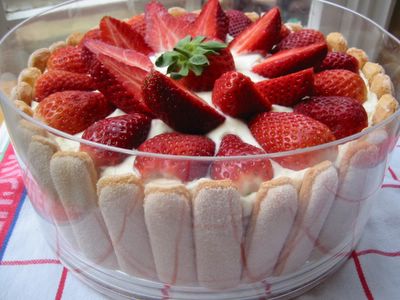
Citrus Trifle
2 large lemons
1 large orange
500 g [2 cups] cream cheese - room temperature
2 cups icing sugar (confectioner's)
2 tsp orange or lemon extract
875 ml [3 1/2 cups] whipping or double cream
1.5 x 175g packages sponge finger biscuits (ladyfingers or savoiardi)
about 3 1/2 cups fresh strawberries
- Squeeze lemon juice and strain into a bowl. Grate orange peel and (optional) squeeze juice; set aside in a separate bowl.
- In a large bowl, with mixer at low speed, beat cream cheese, icing sugar, orange extract, lemon juice and grated orange peel until blended.
- In another bowl, with mixer at medium speed, beat whipping cream until stiff peaks form. Fold whipped cream into the cream cheese mixture with a rubber spatula.
- [Optional] Brush flat side of the sponge fingers with orange juice.
- Line bottom and side of a glass souffle dish or trifle bowl with half the sponge fingers so that the rounded sides are against the side of the bowl.
- Spoon the cream cheese filling into it. Level the top flat.
- To garnish the top of trifle, put 1 unsliced stawberry on the center of trifle. Remove stems and slice remaining strawberries lengthwise in half. Arrange half the strawberries cut-side down around the edge of the the bowl. Arrange the remaining strawberries cut-side up. Refrigerate trifle at least 2 hours to blend flavours.
- Serve with large spoon and scoop serving portions onto dessert plates.
Note: The flavour improves when the filling is allowed to blend overnight. So after step 3 you can put it in the fridge overnight and assemble the trifle the next day.

Traditional biko in the Philippines consists of malagkit (glutinous) rice, coconut milk, sugar, and usually mashed cooked ube (purple yam). Whenever cooking the biko is suggested you could always hear the collective sighs of cooks nearby. For it is quite hard to do with the constant mixing and stirring involved to prevent the bottom from scorching until the malagkit is thoroughly cooked. It was a major undertaking each time biko is cooked. However, I heard that my aunt - Ate Letty - pre-cooks the malagkit to cut down the cooking time drastically and to have a more even consistency of the malagkit. Great idea, I thought and promptly forgot about it for years until I started making this.
In our gatherings among friends in North London, we would always watch out for Gemma G's biko. It is almost always sold out at the end of the party and people would include it in their take home bags everytime. I love the treacly-molasses like taste with just enough sweetness blended in. Gemma was gracious enough to give me the recipe though my first attempts were utter disasters. This is one of those things with very few ingredients but is quite tricky to make. If you're like me and your timing is off you either have a mushy, soft, overcooked biko or a hard, gritty one. Both not nice to have. The grains has to be whole and firm but cooked through something like an al dente pasta or a properly made Italian risotto or Spanish Paella. That is the goal of the whole exercise. So it is important that the malagkit is cooked or rather half-cooked, if not it will become mushy once you are done mixing it up with the sauce. Like most dishes I have in this blog, the ingredients here are borne out of what is available in the UK supermarkets. Therefore mashed ube is out and muscovado sugar is in. I must stress that you should use the latter to achieve that scrumptious taste. If not available, use grated panucha or if absolutely desperate use dark brown sugar. Good luck!
Biko Macapuno
6 rice cooker cups malagkit (glutinous rice)
5 rice cooker cups water
3 x 400 g cans coconut milk
500 g muscovado sugar
1 x 340 g [12oz] bottle of sweetened macapuno (mutant coconut)
- Half-cook 6 cups of malagkit in a rice cooker using only 5 cups of water. As soon as the rice cooker switches from 'Cook' to 'Keep Warm' unplug it to prevent the malagkit from further cooking.
- Pre-heat oven to 190C/fan 170C/375F/Gas Mark 5.
- In a wok or big frying pan, boil the coconut milk. Add the muscovado sugar, stir to dissolve and bring to boil. Add in the sweetened macapuno (including the syrup). Bring to boil again and lower heat. Simmer until thick - about 5-10 minutes.
- Add all the half-cooked malagkit to the wok and stir to mix well.
- Cook on medium-low heat while stirring from time to time until the malagkit is fully cooked (but not mushy and too soft) and the sauce has thickened and covers/clings to the malagkit grains well - about 10-15 minutes.
- Transfer to a baking dish; pat level. Put in the oven for about 5 minutes or just enough to dry out the top a little. Cut into squares and serve warm or cold.
[Optional] Although in my opinion this does not need any more garnishings, you may add the traditional topping for biko - the latik.
*To make latik: Boil a can or two of coconut milk in a heavy-bottomed pan. Add a pinch of salt and (optional) a tablespoon of sugar. Lower heat and simmer until the coconut renders fat and sediment sticks to the bottom of the pan. Once the oil renders and separates from the sediment, stir it frequently to keep it from burning. When the sediment becomes dark brown, remove from heat, drain the oil and scrape off the sediment. This sediment is now your "latik". Put about a 1/2 tsp mound of the latik on top of each of the biko squares. The coconut oil can be used for other dishes or as a natural body and hair moisturiser - but that's a whole different topic.
Variation: Add slices of sweetened langka (jackfruit) to the sauce together with the macapuno. This will make the biko more aromatic.
Note: A rice cooker cup is equivalent to about 2/3 cups.

There are times when you encounter a recipe that looks innocuous, plain, and relatively bland. However, you get surprised with the result's amazing aroma, moist consistency, and scrumptious taste. I was in baking bliss when I took these muffins out of the oven. Quite unpredictably, it exceeded all my expectations. I love the slightly burnt/toasted smell of the sugar sprinkled on top, the aroma of the whole wheat flour baking, the nice tang of morsels of peaches inside. It is also here in this recipe that I learned about keeping the muffins moist by half filling one or two of the muffin cups with water. I love it so much that I gave most of it away otherwise I would be scoffing down every single one of them. :sigh: Baking highs and dieting blues.
This is from the The Genuine American Cookie & Muffin Book by Peter Shaffer.
Peachy Yoghurt Muffin
225 g [8 oz] plain flour
115 g [4 oz] wholemeal plain flour
1 Tbsp baking powder
1/2 tsp bicarbonate of soda (baking soda)
1/2 tsp fine salt
1/2 tsp ground cinnamon
2 large eggs - beaten
240 ml plain natural yoghurt or sour cream
85 g butter - melted
3 Tbsp honey
85 g dark brown sugar
1 tsp vanilla
175 g fresh or canned ripe peaches - peeled (or drained) and chopped
- Preheat oven to 200°C/fan 180°C/400°F/Gas Mark 6. Prepare a 12 cup muffin pan (2 1/2-inch holes) by lining 10 or 11 of the cups with paper liners.
- Mix all dry ingredients in a bowl (flour, wholemeal flour, baking powder, bicarbonate of soda, salt, and ground cinnamon).
- In another bowl mix eggs, yoghurt, butter, honey, brown sugar, and vanilla. Add in the peaches and mix.
- Gradually fold wet ingredients into the dry ingredients. Fold in with a large wooden spoon or rubber spatula until combined. Do not over mix.
- Spoon batter into 10 (or 11) of the 12 prepared muffin cups up. Fill each cup up to 3/4 full. Fill remaining empty cups half full with water to avoid burning the muffin pan and give moisture while baking.
- Sprinkle tops with granulated sugar and bake for 18 to 20 minutes or until tops spring back when gently touched. Do not overbake. Allow to stand for 2 minutes, turn out on wire rack or plate to cool.












